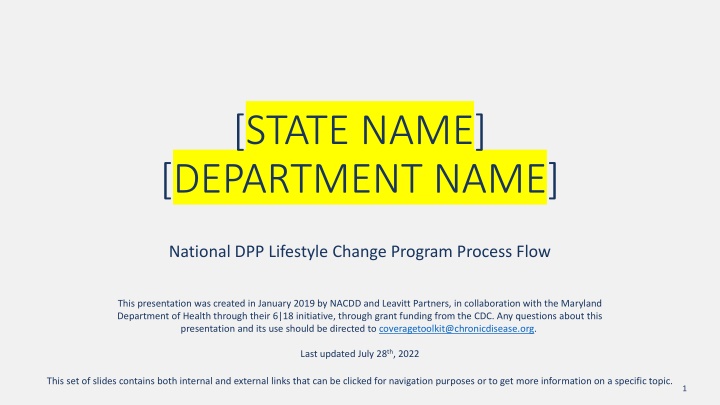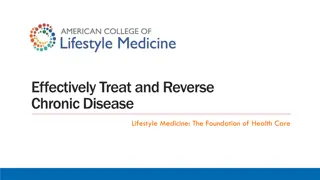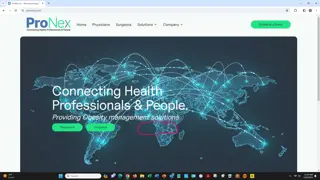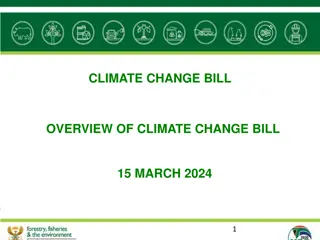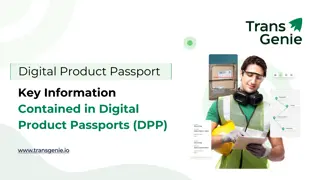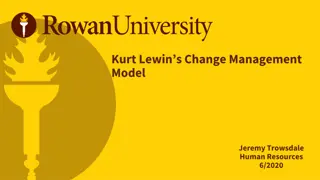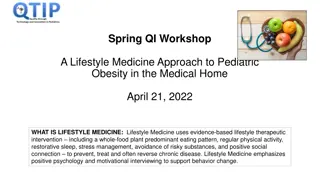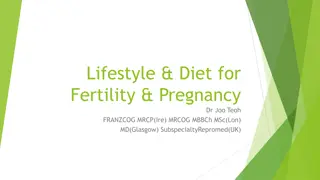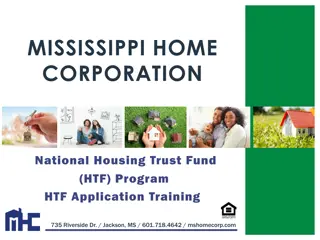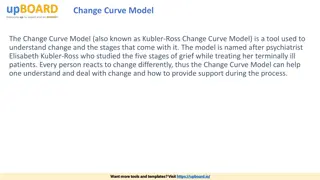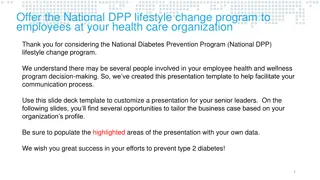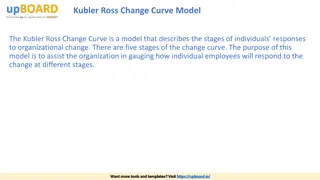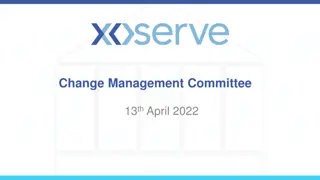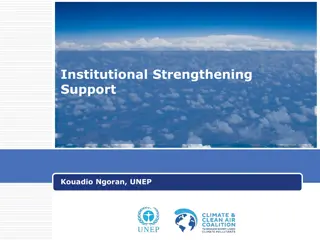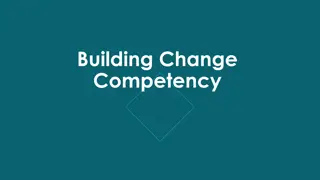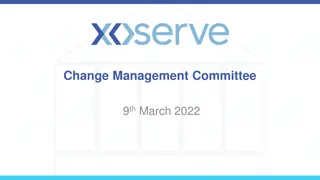National DPP Lifestyle Change Program Process Overview
This presentation deck outlines the process flow for enrolling participants in the National Diabetes Prevention Program (DPP) lifestyle change program. Developed in collaboration with the Maryland Department of Health, it provides a general example overview of participant enrollment and completion. Stakeholders such as state health departments and Medicaid agencies can use this resource, with the option to customize content for specific needs. The slides include links for additional information and navigation within the presentation. External link accuracy may vary, so it's advised to verify them before use.
Uploaded on Sep 21, 2024 | 1 Views
Download Presentation

Please find below an Image/Link to download the presentation.
The content on the website is provided AS IS for your information and personal use only. It may not be sold, licensed, or shared on other websites without obtaining consent from the author.If you encounter any issues during the download, it is possible that the publisher has removed the file from their server.
You are allowed to download the files provided on this website for personal or commercial use, subject to the condition that they are used lawfully. All files are the property of their respective owners.
The content on the website is provided AS IS for your information and personal use only. It may not be sold, licensed, or shared on other websites without obtaining consent from the author.
E N D
Presentation Transcript
[STATE NAME] [DEPARTMENT NAME] National DPP Lifestyle Change Program Process Flow This presentation was created in January 2019 by NACDD and Leavitt Partners, in collaboration with the Maryland Department of Health through their 6|18 initiative, through grant funding from the CDC. Any questions about this presentation and its use should be directed to coveragetoolkit@chronicdisease.org. Last updated July 28th, 2022 This set of slides contains both internal and external links that can be clicked for navigation purposes or to get more information on a specific topic. 1
Purpose of this Presentation Deck This slide deck is intended to be a resource for state health departments, Medicaid agencies, and/or other key stakeholders. Stakeholders are not required to use this process or flow structure. The slides were developed to give a general example overview of the process of enrolling a participant into and completing the National DPP lifestyle change program. While this presentation can be used as-is, users are encouraged to augment these slides with information specific to your State/institution. Please note: there are several locations where hyperlinks have been included. These links go to external websites as well as link back to other sections within this presentation. Removing slides may modify internal link capabilities. The external links were accurate and worked appropriately at the time this slide deck was developed. External sites may have been modified in the interim. As a result, we cannot guarantee the accuracy of any external link contained in this document. Always double check the links you intend to use before presenting. 2
Pre-screening entity / method Is additional information or testing required to confirm eligibility? Contact the referring provider to order additional testing Referral to CDC- recognized organization Intake Potential Participant Identified Run required test(s) / collect info Is the participant eligible to enroll in the National DPP lifestyle change program? National DPP lifestyle change program selection based on Health Plan Provider/Supplier Network Participant Enrolled Participant is not eligible for the program at this time. Inform referring entity & make other referrals as appropriate. Participant s insurance or Medicaid billed for each session Feedback provided to referring entity or provider Participant attends scheduled sessions Yes Data reported to CDC/DPRP No 3
Participant Pathway Steps Refer Using the referral pool, identify potentially eligible participants. Pay for Determine who will be paying for the participant to attend the program. Choose Determine which type of program the participant prefers to attend. Sequential Steps Qualify Confirm that the participant is eligible to participate, meeting all program inclusion criteria. Enroll Enroll the participant into the appropriate National DPP lifestyle change program. Participant attends and completes in-person or virtual classes and participates in the required activities. Attend Data Reporting Feedback is provided to the referring entity/provider and data is provided to the CDC/DPRP. 4 Return to flow overview Return to flow overview
Participant Pathway Referral Sources Refer Pay for Referral Pool Provider Referral* Choose Participant Self-referral Employer Referral Qualify Hospital System Referral Other Referral Sources MCO/Payer Referral Enroll Community Org Referral Attend Data Reporting *Health Care Provider 5 Return to flow overview Return to flow overview
Participant Pathway Referral Sources Refer Pre-screening Resources: Referral Pool CDC/ADA Risk Test Mike s Journey (video) Dionne s Journey (video) Pay for Provider Referral Participant Self-referral Employer Referral Hospital System Referral Choose Other Referral Sources MCO/Payer Referral Community Org Referral Qualify Unique considerations for a participant who self-refers: May result from National DPP lifestyle change program marketing (i.e. promotional prediabetes video, flyers, post cards, or other sources). Participants can self-refer by taking the prediabetes risk test and meeting the score to be considered eligible for the National DPP lifestyle change program. Enroll Attend Data Reporting 6 Return to flow overview Return to flow overview
Participant Pathway Referral Sources Pre-screening Resources: Refer CDC/ADA Risk Test Coverage Toolkit Claims data/eligibility algorithm Referral Pool Pay for Provider Referral Participant Self-referral Employer Referral Hospital System Referral Choose Other Referral Sources MCO/Payer Referral Community Org Referral Qualify Unique considerations for a participant referred by an MCO or payer: MCOs/payers may use claims data (at least 3 months lag time) to search for eligible members based on the CDC prediabetes eligibility criteria. May require marketing (i.e. flyers, post cards, phone calls, email, text messages) through the companies'/customer s preferred communication method. Enroll Attend Data Reporting 7 Return to flow overview Return to flow overview
Participant Pathway Referral Sources Pre-screening Resources: Refer CDC/ADA Risk Test Coverage Toolkit EHR data/eligibility algorithm Referral Pool Pay for Provider Referral Participant Self-referral Employer Referral Hospital System Referral Choose Other Referral Sources MCO/Payer Referral Community Org Referral Qualify Unique considerations for a participant referred by a medical provider: Providers may identify and refer a patient based on their results on one of three qualifying blood tests. Providers may repeat the same test on a second day or may do a different test prior to diagnosing and confirming diagnosis of prediabetes. Providers and medical staff may use EHR data to pre-identify patients who meet the eligibility criteria. Risk tests may be administered by primary care physicians as well as other health professionals such as registered nurses, physician assistants, dentists, ophthalmologists, pharmacists, etc. The risk test may also be administered by other medical office staff. Enroll Attend Data Reporting 8 Return to flow overview Return to flow overview
Participant Pathway Referral Sources Pre-screening Resources: Refer CDC/ADA Risk Test Coverage Toolkit EHR data/eligibility algorithm Referral Pool Pay for Provider Referral Participant Self-referral Employer Referral Hospital System Referral Choose Other Referral Sources MCO/Payer Referral Community Org Referral Qualify Unique considerations for a participant referred by a hospital system: Providers may identify and refer a patient based on their results on one of three qualifying blood tests. Providers may repeat the same test on a second day or may do a different test prior to diagnosing and confirming diagnosis of prediabetes. Hospitals can utilize their EHR to pre-identify patients who meet the eligibility criteria. Hospitals without an in-house National DPP lifestyle change program can contract with one or more community-based or online CDC-recognized organizations. Risk tests may be administered by primary care physicians as well as other health professionals such as registered nurses, physician assistants, dentists, ophthalmologists, pharmacists, etc. The risk test may also be administered by other medical office staff. Enroll Attend Data Reporting 9 Return to flow overview Return to flow overview
Participant Pathway Referral Sources Refer Pre-screening Resources: Referral Pool CDC/ADA Risk Test Mike s Journey (video) Dionne s Journey (video) Pay for Provider Referral Participant Self-referral Employer Referral Hospital System Referral Choose Other Referral Sources MCO/Payer Referral Community Org Referral Qualify Unique considerations for a participant referred by a community organization: May require marketing (e.g., promotional prediabetes video, flyers, post cards, etc.). Potential participants can self-refer by taking the prediabetes risk test and meeting the score to be considered eligible for the National DPP lifestyle change program. Enroll Attend Data Reporting 10 Return to flow overview Return to flow overview
Participant Pathway Referral Sources Pre-screening Resources: Refer CDC/ADA Risk Test Coverage Toolkit Mike s Journey (video) Dionne s Journey (video) Referral Pool Pay for Provider Referral Participant Self-referral Employer Referral Hospital System Referral Choose Other Referral Sources MCO/Payer Referral Community Org Referral Qualify Unique considerations for a participant referred by an employer: Employers may have health insurance company use claims data (3 months lag time) to search for eligible members based on the CDC prediabetes eligibility criteria. Employees can self-refer by taking the prediabetes risk test and meeting the score to be considered eligible for the National DPP lifestyle change program. Employers may do a wellness assessment of their organization to justify offering the National DPP lifestyle change program and follow-up with employees who indicated interested. May require marketing (e.g., flyers, post cards, phone calls, email, text messages) through the companies'/employee s preferred communication method. Enroll Attend Data Reporting 11 Return to flow overview Return to flow overview
Participant Pathway Referral Sources Pre-screening Resources: Refer CDC/ADA Risk Test Coverage Toolkit Mike s Journey (video) Dionne s Journey (video) Referral Pool Pay for Provider Referral Participant Self-referral Employer Referral Hospital System Referral Choose Other Referral Sources MCO/Payer Referral Community Org Referral Qualify Enroll Additional Referral Sources: State health information exchanges (HIEs) Local Health Departments (LHDs) Chronic Disease Self Management Program (CDSMP) and Diabetes self-management education (DSME) and support programs Attend Data Reporting 12 Return to flow overview Return to flow overview
Participant Pathway Payment Options Refer Who is paying for their participation in the National DPP lifestyle change program? Pay for Choose Participant Self- payment Employer or other 3rd party Participant s Insurance Qualify Enroll Pull list of participating CDC-recognized organizations within payer s network.* Continue to Program Type Options. Attend Yes No Data Reporting *Self-payers may choose any CDC-recognized organization 13 Return to flow overview Return to flow overview
Participant Pathway Program Options Refer Participant choses a delivery mode from the list of DPPs available in payer s network. Pay for Review the list of DPPs available in payer s network+, or otherwise available, who are accepting new participants. Choose Qualify In-person / Online Hybrid Online / Telehealth In-person Enroll Participant selects preferred organization and referral is initiated. Attend Data Reporting Self-payers may choose any CDC-recognized organization + Participants choosing a CDC-recognized organization outside of their insurance network may be responsible for a portion of the payment. 14 Return to flow overview Return to flow overview
Participant Pathway Eligibility Decision Tree Refer Pay for Choose Qualify Enroll Attend Data Reporting The eligibility criteria for the MDPP differ slightly from those pictured above. For more information, please see the coveragetoolkit.org website. 15 Return to flow overview Return to flow overview
Participant Pathway Common Enrollment Needs Refer Participants who are Self-Referred, Community Organizations and Employer Wellness Programs Pay for Reason for Referral Score on risk test DoIHavePrediabetes Campaign Suspicion of prediabetes Must confirm all qualification elements State and Local public marketing campaigns Told by a provider they are at risk for developing type 2 diabetes Choose Qualify Eligibility Confirmation Needed Diagnosis of Obesity BMI calculation, or Medical Diagnosis Qualifying Blood Test HbA1c, FPG, or OGTT Detailed Health History Enroll Attend Data Reporting 16 Return to flow overview Return to flow overview
Participant Pathway Common Enrollment Needs Refer Participants Referred from MCOs, Other Payers, Medical Providers, & Hospitals or Health Systems Pay for Reason for Referral Diagnosis of Obesity Medical Diagnosis (ICD-9 or ICD-10 code) Qualifying Blood Test HbA1c, FPG, or OGTT Detailed Health History History of Gestational Diabetes Choose Qualify Enroll Eligibility Confirmation Needed Depending on date of query, may need blood test or detailed health history to confirm inclusion/exclusion. Attend Data Reporting 17 Return to flow overview Return to flow overview
Participant Pathway Lifestyle Change Program Curricula Introduction Must occur first, per CDC. Foundational Classes Recommended to occur in this order per CDC. Present all of these modules Can occur in any order per CDC. Refer 7. Burn More Calories Than You Take In 13. Take Charge of Your Thoughts 10. Find Time for Fitness 1. Intro to the Program 4. Eat Well to Prevent T2 Months 1 6 16. Stay Motivated to Prevent T2 Pay for 0. Program Overview* 8. Shop and Cook to Prevent T2 11. Cope with Triggers 14. Get Support CDC 2. Get Active to Prevent T2 5. Track Your Food recommends this class occur at the 6 month mark. *May be offered during session 1 if no session zero occurs. Choose 15. Eat Well Away from Home 6. Get More Active 9. Manage Stress 12. Keep Your Heart Healthy 3. Track Your Activity Qualify Present at least six* of these modules Can occur in any order per CDC. Conclusion Must occur last, per CDC. Medicare Only Year 2 Choose 12 modules from any approved curricula, presented monthly for year 2. *Some DPPs may offer all 9 modules instead of 6 Month 7 12 module options Stay Active Away from Home Months 7 12 Enroll 17. CHOOSE ONE MODULE Stay Active to Prevent T2 More About T2 20. CHOOSE ONE MODULE 22. Prevent T2 for Life! Get Enough Sleep Get Back on Track Take a Fitness Break 18. CHOOSE ONE MODULE 21. CHOOSE ONE MODULE Attend CHOOSE 12 MODULES 1. 12. 22. CHOOSE ONE MODULE* Have Healthy Food You Enjoy More About Carbs 19. CHOOSE ONE MODULE When Weight Loss Stalls Data Reporting 18 Return to flow overview Return to flow overview
Participant Retention in the National DPP Lifestyle Change Program Important Early Program Retention Milestones Referring Provider Contact when a Participant Disengages General Retention Strategies General strategies to boost retention include: Use of incentives (if allowed) CDC retention tool Important retention modules can be used at the after the following milestones: Program Overview session Get Active session Track Your Activity session Eat Well session Track Your Food session Get Support session Week 16 module A referring provider s involvement can often boost success rates for their patients who participate. If a participant disengages, the provider s office can: Contact the participant directly Encourage continued participation in the NDPP lifestyle change program Address concerns and commit participant to continue program 19 Return to flow overview Return to flow overview
Participant Pathway Retention Decision Tree Refer Pay for Choose Qualify Enroll Attend Data Reporting 20 Return to flow overview Return to flow overview
Participant Pathway Two Separate Feedback Pathways Exist Refer CDC / DPRP Recognition Referring Entity / Provider Pay for Choose Data Reporting Qualify Standards for CDC-recognition The feedback required includes 24 data points found in Table 4 of the 2018 DPRP standards document Enroll Attend Data Reporting 21 Return to flow overview Return to flow overview
Participant Pathway Two Separate Feedback Pathways Exist Refer CDC / DPRP Recognition Referring Entity / Provider Pay for Choose Provide Feedback Regarding: - Enrollment - Individual Participant progress o Attendance o Weight Loss o HbA1c and BMI changes o Physical Activity Qualify Enroll Feedback Methods o EHR o Secure Email o Mail o Secure Fax o State Data Platforms Attend Data Reporting 22 Return to flow overview Return to flow overview
Coding and Billing Considerations for the National DPP Lifestyle Change Program Billing Medicaid Billing Medicare Billing a Private Payer When Billing Medicaid: Type of billing, claims versus invoice, depends on type of contract established with Medicaid Bill as established in physician fee schedule or invoicing requirements in contract Use appropriate HCPCS/CPT codes, as directed by the state Include appropriate ICD-10 diagnosis codes When Billing Medicare: Bill at required timepoints After session 1 After sessions 2 4 After sessions 5 9 After sessions 10-19 (at least 2 classes attended in months 7-9) After sessions 20-22 (at least 2 classes attended in months 10-12) Use appropriate HCPCS codes Include appropriate ICD-10 diagnosis codes Glucose lab test required by Medicare to qualify When Billing a Private Payer: Type of billing, claims versus invoice, depends on type of contract established with payer Bill as established in physician fee schedule or invoicing requirements in contract Use appropriate HCPCS/CPT codes Include appropriate ICD-10 codes May not be required when invoicing depends on type of contract established with payer 23 Return to flow overview Return to flow overview
Information about Testing and Medical History to Qualify for the National DPP Lifestyle Change Program Body Mass Index (BMI) The BMI looks at the ratio of a person s weight and height (weight in kg/ height in m2). This can be used as an indicator of obesity. The CDC provides a calculator to measure BMI in adults. Gestational diabetes is a condition developed during pregnancy affecting how the body responds to glucose (i.e. sugar). This is similar to other types of diabetes, but blood sugar often returns to normal soon after delivery. It is most common in women over 25 years old, women who have a personal or family history of the condition, women who have a BMI of 30 or greater, and women of minority races. Hx of Gestational Diabetes CDC/ADA Prediabetes Risk Test The CDC and ADA provide a risk test to measure if someone is at risk for prediabetes. This test incorporates age, family history, and several health-related elements. This blood test, also referred to as A1c, HbA1c, glycated hemoglobin, and glycohemoglobin, measures the average level of blood sugar over the past 2 to 3 months. Values between 5.7% and 6.4% may indicate prediabetes. This test must be interpreted by a licensed clinician for a diagnosis to be made. Hemoglobin A1C This blood test, also referred to as FPG, is drawn after someone has not eaten anything for at least eight hours. It measures the level of blood glucose (i.e. sugar) when fasting. Values between 100 to 125 mg/dL may indicate prediabetes. This test must be interpreted by a licensed clinician for a diagnosis to be made. Fasting Plasma Glucose This test, also referred to as OGTT, is performed by taking a baseline blood sample, then having the individual drink a liquid that contains a known amount of glucose. Blood is then drawn according to a set time schedule to measure how the body responds to the glucose. Values between 140 and 200 mg/dL may indicated prediabetes. This test must be interpreted by a licensed clinician for a diagnosis to be made. Oral Glucose Tolerance Test 24 Return to flow overview Return to flow overview
